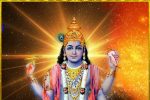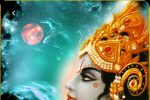NAME 48
Padmanābhaḥ पद्मनाभः
A divine lotus springs up from His navel, from which arose the lord of creation Brahmā. Brahma refers to the Brahman and Brahmā refers to the lord of creation. This also overrides the myth that Lord Viṣṇu is not merely the sustainer of the universe. This nāma clearly says that He is also the Creator. The true nature of the Brahman is being described. Muṇḍaka Upaniṣad says (I.1), “viśvaya kartā bhuvanasya goptā” which means He is the creator of the universe and the supporter of the universe.
Yajur Veda (IV.vi.2.7) says, “ajasyanābhāvadhyekamarpitaṁ” which means ‘the One (ekam) is established (arpitam) in the centre (nābhi) of the Unborn (ajasya) waters.” This mantra of Yajur Veda talks about the manifestation of the universe.
The Lord Who has a Lotus (From Which the World Evolved) Growing on his Belly. One- from whose navel the lotus (the cause of the Universe) emanates
“Sarva Jagat Karanam PadmamNabhauYasya Sa Padmanabhah”-
One from whose navel (“Nabhi”) springs the Lotus (“Padma”), which is the seat of the four-faced Creator, Brahmaaji. Padmanaabhah – He who is the source of the Universe
Padma means Lotus and Naabhi means navel so Padmanaabha is someone who has a Lotus in his navel. As Sri Adi Sankara puts it, it’s not an ordinary Lotus, but ‘SarvajagatKaaranamPadmam – the underlying Cause for all Creation being the seat of Brahma the Creator’. The Lotus denotes the Kaal Chakra or Cycle of the Yugas.
There are 7 nether worlds and seven upper regions including the Earth. The Bhagavata Puranas calls the seven lower regions bila-svargas (“subterranean heavens”) and these are – Atalam, Vitalam, Nitalam, Rasatalam, Mahatalam, Sutalam and Patalam.
The 7 upper regions including the Earth are: Bhulokam (Earth), Bhuvarlokam, Suvarlokam, Magarlokam, Janalokam, Tapalokam and Satyalokam. This is also part of the Pranayam Mantra when we recite – Om Bhuh, Om Bhuvaha, OgumSuvaha, Om Mahaha, Om Janaha, Om Tapaha, Ogum Satyam….Om Tat SaviturVarenyam……
These 14 worlds make up the Cosmos and also referred as Brahmaanda or Anda. It’s referred as Hiranygarbha (in Rig Veda 10.121) meaning the Golden Foetus. The Upanishads elaborate that the Hiranyagarbha floated around in emptiness for a while, and then exploded, something that the Big Bang theory also explains as the beginning of the Cosmos. According to the Vedas and Upanishads, there are several millions of such Andas and the Lord sustains them all.
Sri Radhakrishna Sastri gives a beautiful and simple explanation to enable the appreciation of this Nama. In our normal life, the baby is connected to the mother before birth and at the time of birth through the umbilical cord through which it gets nourishment from the mother. Similarly, the cord from the Lord’s navel is nothing but the Universe in its primordial form which looks like a Lotus that has not bloomed. This is prior to its full bloom through Time and He is the nourisher of his Creation i.e. Brahma.
४८. ॐ पद्मनाभाय नमः।
48. Om Padmanābhaay Namah
Padmanaabhah – One from whose navel (“nabhi”) springs the Lotus (“padma”), which is the seat of the four-faced Creator, Brahmaaji.
Lotus in Hinduism represents Truth or any of Its manifested powers. The creative faculties in man flow from the navel area (center: naabhi), and manifests as the ‘four-faced’ inner equipment (Antahkarana) constituted of the mind, intellect, Chit and ego.
In the Yoga-sastras, we find a lot of details regarding this concept. According to them every “idea” springs from Him (Paraa), and then at the navel area, each of them comes to be ‘perceived’ (Pasyantee).
Thereafter they play in the bosom as thoughts (Madhayamaa), and at last they are expressed (Vaikharee) in the outer fields-of –activity.
In this discussion-upon the evolutionary stages through which every “idea” becomes an “action” – we gather a clearer insight into the meaning of the symbolism of “the Creator seated on the lotus”, which springs forth from the navel of the Lord, the Supreme Vishnu.
INTERPRETATION GUIDED BY SANT VANI (WORDS OF SAINTS)
PADMANĀBHAḤ (also names 196, 346)
The one who has a lotus in His navel.
This is a samasa, a compound word in Sanskrit indicating a being with certain characterstics. Padmanābha is one who has a padma, a lotus in His nābhi, navel. Brahman which is satyamjñānamanantam, itself free from birth, is the nābhī, the navel, that is, the cause of this entire jagat. From this navel, the lotus blooms forth in the form of the world.
The navel that contains within itself this entire Universe. The lotus in the navel of the birthless being who is “the cause of Brahmā” He, from whose Nābhi (navel) springs forth that Padma (lotus) on which is seated the four-faced secondary-creator of the world i.e.Brahmā.
This name and form of the Supreme being has a deep symbolic and allegorical meaning. “The creative faculties in humans flow from the Nābhi (navel) and manifest as Brahmā – the ‘Antaḥkaraṇa’ (अन्तःकरण) – the four-layered inner instrument of consciousness consisting of Buddhi (बुद्धि) or intellect, Manas (मनस्) corresponding roughly to the mind, Ahaṃkāra (अहंकार) the ego or the “I” and citta (चित्त), the seat of memory and feelings“– the four-faced Brahmā is an allegorical reference to this and since Brahmā with his consort Sarasvatī is the creative principle and the repository of knowledge, specifically the Vedas – therefore the positioning of Brahmā on the lotus emanating from the navel of the supreme being is to be interpreted as the ‘blooming’ of the “creative/spiritual faculties.”
In humans the navel is the center of gravity for sitting, standing, walking or running. It is also the meeting point of the physical and the mental – the psychosomatic (mind-body) junction-point and is crucial for harmonious functioning of the body-mind-soul complex. When faced with great danger, you get a ‘sinking-feeling’ in the “pit” of your stomach – indicative of this psychosomatic connection.
In Chakra-symbology too this region corresponds approximately to the Manipūra Chakra. The word Manipūra literally means the “city (pura) of the beautiful gem (mani)” and corresponds to the Solar plexus or the Solar center of the body and just as the governing principle in the solar-orb of the Sun is Viṣhṇu, here too in the solar-center of the human body the governing principle is Padmanābhaḥ. This chakra is again the junction-point of the Prāna-Vayu and Apāna-Vayu where they become Samāna-Vayu – literally meaning balance and therefore responsible for nourishment and well-being and providing the essential fuel for the spiritual journey. It is also the junction-point from where the higher levels of human consciousness begins and the blooming of this “lotus” is crucial to develop intuitive capabilities and access the higher levels of human consciousness – the heart, throat and other centers.
Please watch from 5.08 min onwards
The navel that contains within itself this entire Universe. The lotus in the navel of the birthless being who is “the cause of Brahmā” He, from whose Nābhi (navel) springs forth that Padma (lotus) on which is seated the four-faced secondary-creator of the world i.e.Brahmā.
Brahmā, the creator, is depicted as being seated in the padma, lotus arising out of the navel of Lord Viṣhṇu. Here, Lord Viṣhṇu is none other than Parameśvara and is presented as the total. The Lord himself becomes the creator called Brahmā, the sustainer called Viṣhṇu or the withdrawer called Rudra. We understand that each is a standpoint referring to a particular function.
Brahmā creates the whole world. The entire world which is created is an opened lotus. The world is in the navel of Parameśvara, the sadātmā of Parameśvara, as the blossomed lotus.
Brahmā has the four Vedas as his four heads. Being the creator there should be knowledge with him and therefore his consort is Sarasvatī who is knowledge. The Lord is the creator of the creator Brahmā also.
Nābhi, navel is the axle, the cause. Creation implies motion, change. It is only the wheel that moves. The axle remains constant. It does not move. It is kūṭastha. Therefore, this entire lotus is the created jagat with Brahmā. Brahmā is included in this lotus. The adhiṣṭhāna, the truth, of everything is Brahman and itself does not have another adhiṣṭhāna.
Ananta Chaturdashi is believed to be the day when Lord Vishnu appeared in the form of Anantha Padmanabha – the Ananta Sayana form of Lord Vishnu – reclining on Ananta.
In the Mahabharata, Shri Krishna advises Yudhishthira to observe Ananta Vrata for 14 years to get back his lost kingdom. A fast is observed from sunrise to sunset by Lord Vishnu devotees.



